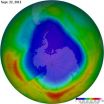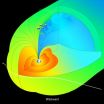(Press-News.org) Satellite imagery indicated that Tropical Storm Tony is a small, compact storm, traveling through the central Atlantic Ocean.
On Oct 23, Tropical Depression 19 strengthened into Tropical Storm Tony in the central Atlantic Ocean. NOAA's GOES-13 satellite captured an image of Tony on Oct. 24 at 7:45 a.m. EDT that revealed that Tony is relatively small as it moves through the central Atlantic. Tropical storm force winds extend outward up to 70 miles (110 km) from the center. Tony is just over 140 miles in diameter as seen on the GOES-13 image. The GOES-13 satellite image was created by NASA's GOES Project at the NASA Goddard Space Flight Center, Greenbelt, Md.
Infrared satellite data from NASA's Aqua satellite shows that cloud top temperatures have cooled to -70 Celsius, indicating some very high, strong thunderstorms within.
At 5 a.m. EDT today, Oct. 24, Tony's maximum sustained winds are near 45 mph (75 kph). Some additional strengthening is expected today, followed by gradual weakening. The center of tropical storm Tony was located near about 1,415 miles (2,275 km) west-southwest of the Azores, near latitude 27.4 north and longitude 47.9 west. Tony is moving toward the east-northeast near 16 mph (26 kph) and the National Hurricane Center expects the storm to continue in that direction and speed up over the next two days.
Tony is also battling wind shear from the southwest and is headed into cooler waters. Both factors are expected to weaken Tony later in the week.
VIDEO:
This animation of NOAA's GOES-13 satellite observations from Oct. 21-24, 2012, shows Tropical Storm Sandy become a hurricane just before making landfall in Jamaica and Tropical Storm Tony form and...
Click here for more information.
INFORMATION:
NASA sees tiny Tropical Storm Tony traveling
2012-10-25
ELSE PRESS RELEASES FROM THIS DATE:
Living power cables discovered
2012-10-25
A multinational research team has discovered filamentous bacteria that function as living power cables in order to transmit electrons thousands of cell lengths away.
The Desulfobulbus bacterial cells, which are only a few thousandths of a millimeter long each, are so tiny that they are invisible to the naked eye. And yet, under the right circumstances, they form a multicellular filament that can transmit electrons across a distance as large as 1 centimeter as part of the filament's respiration and ingestion processes.
The discovery by scientists at Aarhus University ...
Americans use more efficient and renewable energy technologies
2012-10-25
Americans used less energy in 2011 than in the previous year due mainly to a shift to higher-efficiency energy technologies in the transportation and residential sectors. Meanwhile, less coal was used but more natural gas was consumed according to the most recent energy flow charts released by Lawrence Livermore National Laboratory.
Wind power saw the biggest jump from .92 quadrillion BTU, or quads, in 2010 up to 1.17 quads in 2011. (BTU or British Thermal Unit is a unit of measurement for energy and is equivalent to about 1.055 kilojoules).
"Wind energy jumped significantly ...
U of A medical researchers use simple intervention to improve osteoporosis treatment rates
2012-10-25
Older patients who visited local ERs for chest pain or breathing problems and had chest x-rays reveal unknown spinal fractures, were more apt to receive osteoporosis treatment afterward if a simple intervention was used, recently published medical research from the University of Alberta has found.
Treatment rates for the bone-thinning condition substantially improved when patients and their family doctors received follow-up information about the warning signs and risk factors. It is the first and only trial in the world that looked at spinal osteoporosis.
Of those ...
Pigs look healthy but test positive for flu at fairs; transmission seen between pigs and humans
2012-10-25
COLUMBUS, Ohio – More than 80 percent of pigs that tested positive for influenza A virus at Ohio county fairs between 2009 and 2011 showed no signs of illness, according to a new study.
Ohio State University researchers tested 20 pigs each at 53 fair events over those three summers and found at least one flu-positive pig at 12 fairs – almost a quarter of fairs tested.
The influenza strains identified in pigs in this study include H1N2 and H3N2 viruses – strains that have been circulating in pigs since 1998. In 2011, all of the H3N2 and H1N2 isolates found in pigs ...
Which candidate will be best for the stock market...?
2012-10-25
DeKALB, Ill. -- With Election Day less than a month away, television is filled with talking heads spreading the conventional wisdom of what a Republican or Democratic president might mean for the economy.
However, a group of researchers says, when it comes to the relationship between presidential politics and the behavior of the financial markets, conventional wisdom may not be so wise.
The researchers reviewed more than 40 years of data (1965-2008) in studying the relationship between security returns and four variables: the political affiliation of the president; ...
CU-Boulder researchers uncover new target for cancer research
2012-10-25
In a new paper released today in Nature, BioFrontiers Institute scientists at the University of Colorado Boulder, Tom Cech and Leslie Leinwand, detailed a new target for anti-cancer drug development that is sitting at the ends of our DNA.
Researchers in the two scientists' laboratories collaborated to find a patch of amino acids that, if blocked by a drug docked onto the chromosome end at this location, may prevent cancerous cells from reproducing. The amino acids at this site are called the "TEL patch" and once modified, the end of the chromosome is unable to recruit ...
2012 Antarctic ozone hole second smallest in 20 years
2012-10-25
WASHINGTON -- The average area covered by the Antarctic ozone hole
this year was the second smallest in the last 20 years, according to
data from NASA and National Oceanic and Atmospheric Administration
(NOAA) satellites. Scientists attribute the change to warmer
temperatures in the Antarctic lower stratosphere.
The ozone hole reached its maximum size Sept. 22, covering 8.2 million
square miles (21.2 million square kilometers), or the area of the
United States, Canada and Mexico combined. The average size of the
2012 ozone hole was 6.9 million square miles (17.9 ...
Plants provide accurate low-cost alternative for diagnosis of West Nile Virus
2012-10-25
While the United States has largely been spared the scourge of mosquito-borne diseases endemic to the developing world—including yellow fever, malaria and dengue fever—mosquito-related illnesses in the US are on the rise. One pathogen of increasing concern in the U.S. is an arbovirus known as West Nile.
Now Qiang "Shawn" Chen, a researcher at Arizona State University's Biodesign Institute and a professor in the College of Technology and Innovation has developed a new method of testing for West Nile, using plants to produce biological reagents for detection and diagnosis. ...
NASA study using cluster reveals new insights into solar wind
2012-10-25
A new study based on data from European Space Agency's Cluster mission shows that it is easier for the solar wind to penetrate Earth's magnetic environment, the magnetosphere, than had previously been thought. Scientists from NASA's Goddard Space Flight Center in Greenbelt, Md. have, for the first time, directly observed the presence of certain waves in the solar wind—called Kelvin-Helmholtz waves that can help transfer energy into near-Earth space—under circumstances when previous theories predicted they were not expected.
The recent paper, published on Aug 29, 2012, ...
Galaxy halos are produced by orphan stars, findings indicate
2012-10-25
Irvine, Calif., Oct. 24, 2012 – Isolated stars kicked to the edges of space by violent galaxy mergers may be the cause of mysterious infrared light halos observed across the sky, according to UC Irvine and other astronomers.
"Background glow in our sky has been a huge unanswered question," said UCI physics & astronomy professor Asantha Cooray, lead author of a paper about the discovery in the Oct. 25 issue of the journal Nature. "We have new evidence that this light is from stars that linger between galaxies. Individually, they're too dim to be seen, but we think we're ...



